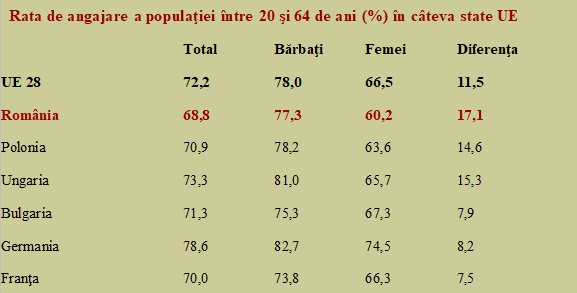Romania ranked fourth among the EU member states last year in terms of employment growth, according to data published by Eurostat.
With an advance of 2.5 percentage points, we ranked after Bulgaria (+ 3.6%), Slovenia (+3.3%) and Portugal (+ 2.8%) and advanced up to 68.8%, close to the target of 70% set for 2020.
The Europe 2020 strategy stipulates the target of reaching an employment of at least 75% at the EU level, but this objective has been adapted to different national targets depending on specific conditions in each country. Overall, the progress achieved was from 71.1% in 2016 to 72.2% in 2017. In men’s category, it reached 78%, while in women’s category there was a percentage of only 66.5%.
For reference, we mention that the highest employment rates for the population aged between 20-64 were obtained by Sweden (81.8%), Germany (79.2%), Estonia (78.7%), the Czech Republic (78.5%), the United Kingdom (78.2%), the Netherlands (78%), Denmark (76.9%), Lithuania (76%) and Austria (75.4%) and all these rates are above the benchmark of 75%.
At the opposite end there have been placed Greece (57.8%, despite an increase of 1.6 percentage points last year), Italy (62.3%, + 0.7pp), Croatia (63.6%, + 2.2pp) and Spain (65.5%, + 1.6pp), which creates a quite clear picture of an important cause for the economic performance gap between the north and south of the continent.
To be noted as a national specific element, with a gap of over 17 percentage points between employment rates in men and women, Romania ranked among the countries with the highest values in this field, while Malta (26.1 pp), Italy (19.8 pp) and Greece (19.7 pp) had the record results. Well above Poland and Hungary and much above the neighbour from the south of the Danube, which had a much smaller gap, similar to Germany and France (see table).
*
- Employment rate in population between 20 and 64 (%) in some EU states
*
It is also worth noting that the Romanian men reached very close to the EU average and are a substantially over the Bulgarians (although they are still far from the Polish and Hungarian “zeal”). In contrast, those who are farer from the European practice and lower the national average are women. This is also the main direction on which we can recover from the gaps compared to other EU states, older or newer members.
The big problem: employment in the 55-64 age group
The situation is also maintained in the age group that is sensitive in terms of employment opportunities (55-64 years), where we are well below the European average and significantly below the situation in other former socialist states.
This is the second major direction on which we should focus our efforts of improving some statistical indicators showing that far less than one man in two and about one in three women of this age are still working.
*
- Employment rate in population between 55 and 64 (%) in some EU states
- total / men / women
*
Interestingly, in this age group, gender gaps are similar to those in Poland and Hungary (of course, on a somewhat lower level), but far beyond neighbour country Bulgaria, which performed even over Germany in this matter.
That, although Bulgarian men close to the elderly category have practically reached the European level in terms of employment.
It is worth noting, from the cultural affinity point of view, the minimum difference of employment in this age group that exists at our French cousins, though not due to the superior zeal of women compared to the European average but due to the more precarious situation of men who are below the threshold of one in two and well below the EU average.












